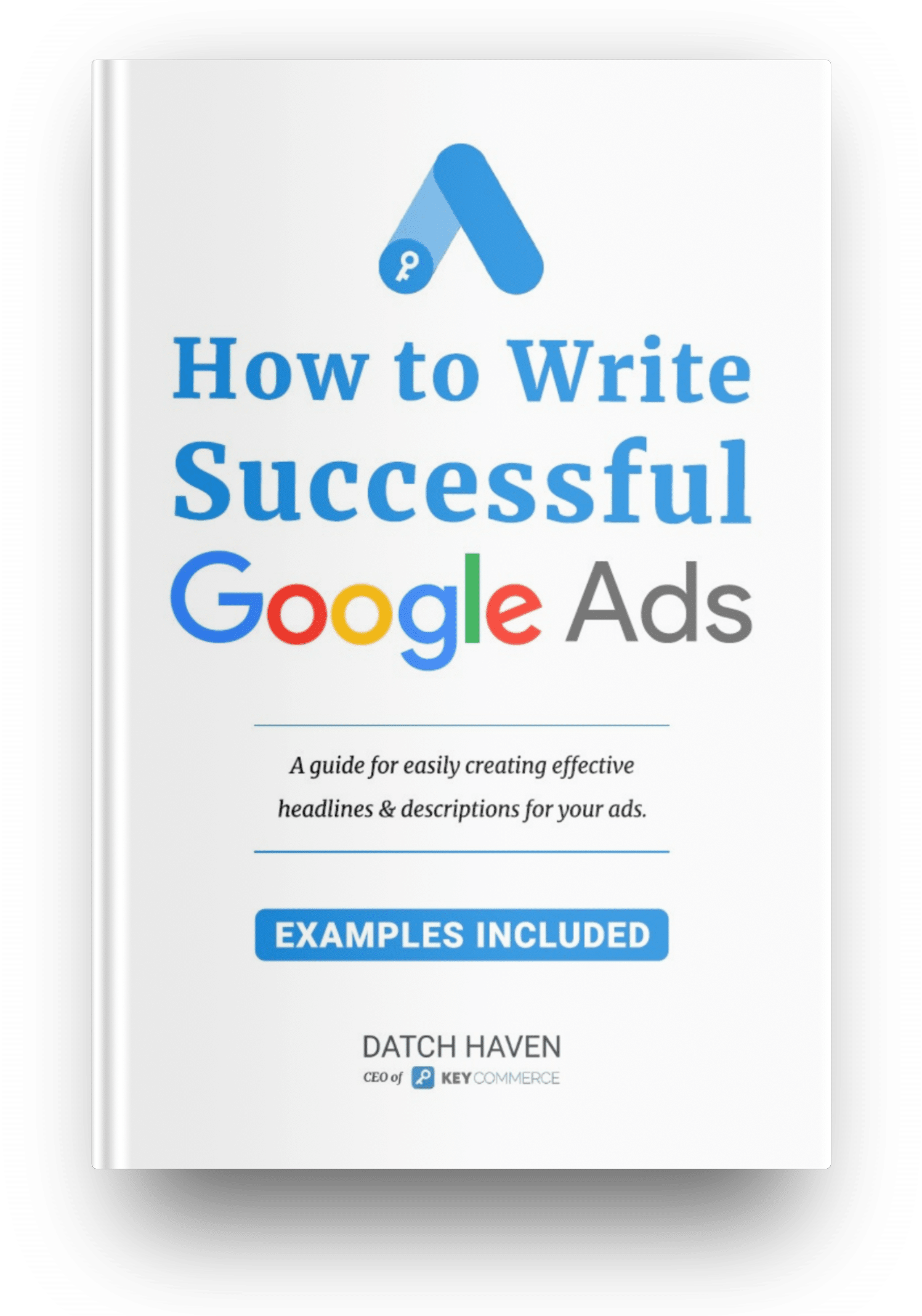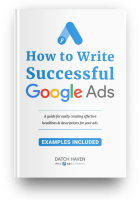It’s affordable and delivers results for a long period once you build authority. With an excellent SEO and content marketing strategy, you should rise to the top in no time.
You will, however, need to battle out the big boys, which can be a daunting task, especially if you are in highly competitive niches such as health and digital marketing.
The only way to do this is to befriend Google and create content that your competitors aren’t. However, this process can take several months before noticing significant results.
But what do you do when you want quick sales? You can’t seriously wait for 4-6 months to get a sale while you can launch Google ads today and get hot leads, can you?
Guess no. But how do you do it right and get a bang on your buck when most people lose money in their first attempts?
It’s all in this guide. Read to the last word.
What are search campaigns?
You see, Google has many advertising options. Choose to display your ads in search results, in websites and blogs, in mobile apps, or YouTube videos.
Of all the options, search advertising is probably the best because it targets people who are actually searching for the same kind of services or products.
When you bid on a keyword, say, for example, ‘women dresses sale,’ Google will show your ads to people searching for the same. So, search advertising delivers insanely high results.

Bing also has search advertising, but Google handles over 90% of all search engine queries. So, it’s worth focusing on this platform first.
Keywords, Ad groups, and campaign structure
Keywords are search terms you bid on. They are what your customers input into Google’s search bar. When they do, Google will show your ads to them since you have bid for them.
Airy is a company that deals specifically with women’s clothing. If you search for ‘women dresses sale,’ their ad will show up since they targeted those keywords.
By default, AdWords has the keywords set to broad match. But you can include multiple match types to one keyword. You can use the exact and phrase match, as well.
Ad groups are below your campaigns and harbor several of your keywords. You can have several ad groups in one campaign targeting different tiny segments of customers.
Campaigns hold all your ad groups and keywords in those ad groups. You can launch different campaigns and pause when you need to optimize for other keywords.
As a beginner, don’t launch many campaigns because it will be a tussle managing. Begin with a few ones to test the waters. You can ‘go all in’ when you have mastered the concept.
Here is an illustration that depicts this structure.
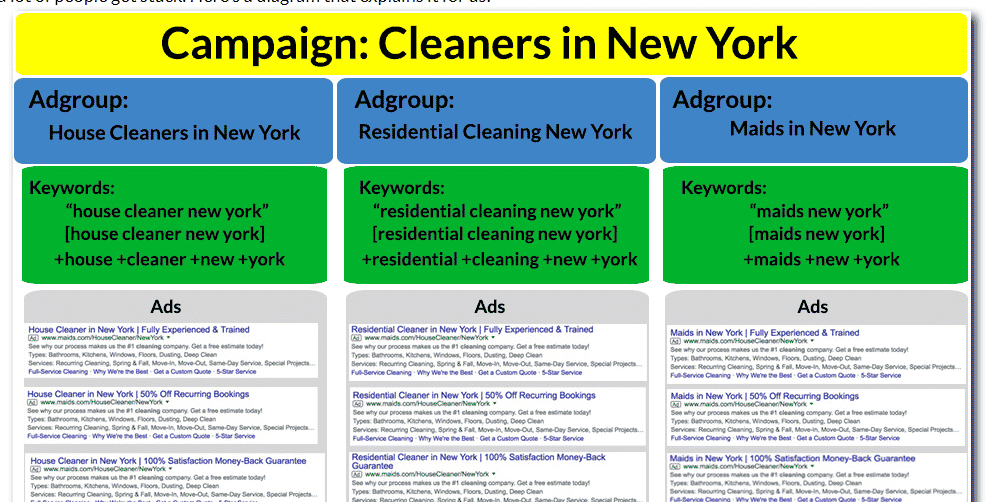
You can also read everything about this structure in this blog post.
What’s the goal of launching Google ads?
There are different reasons you may opt for Google Ads. Here are some of the goals:
To generate sales: Google might charge 30% for every conversion, but you will get much more. Some people are making up to seven figures in profit from their e-commerce stores, running Google search ads. If this is your goal, follow steps in this guide to create campaigns that knock it out of the park every time.
Brand and product awareness: When you come up with new innovative products, you will want your customers to know about them before they buy. Since most don’t know about it, you need to run a product awareness campaign. For example, most people didn’t know about Blendjet until they run product awareness campaigns.
To generate leads: You can generate lots of leads running Google ads. Actually, Google does not charge you unless there is a specific form of action on your ads. Once someone clicks on your ad, he will land on your site. Depending on how your landing page is optimized for conversions, some will convert to customers. Google charges you for those leads.
Website traffic: You can’t rely on organic traffic alone. Supplement it with search advertising. The most challenging part of any e-commerce store is traffic. The moment you have traffic, you have leads and sales. Google allows you to set this as your goal.
You can promote a specific sales page or whole site and get tons of traffic, which converts easily since it’s composed of people already interested in what you sell.
The main goal of running Google ads is to generate profits. That’s the whole purpose of marketing. If it doesn’t drive forth results for your e-commerce store, why run them?
To expound on this, you should read this RLSA campaign guide for e-commerce. Open it in a new tab and read it thereafter.
Mistakes that cause most people to lose their cash in search campaigns
Guess what? You will not make millions from your first few Google ads campaigns (at least not like someone who has been in it for long).
But if you want to avoid the hurdles and create top-notch campaigns, avoid these mistakes that most e-commerce store owners make:
Not using multiple tools to undertake keyword research
Keywords are critical for the success of Google ads campaigns. It depicts the search intent of your customers. Once you know what they are looking for, you will provide it to them.
Marketing is not about creating products and fish for customers. It’s about considering what your customers are searching for and creating excellent products to meet their needs.
You should begin researching for keywords to target way before launching your campaigns. Don’t rely on Google Keyword Planner alone or follow Google recommendations. You need enough data to select the right keywords. The two can’t give all that.
You can even check out Ahrefs; it’s a great tool to spy on your competitors and the keywords they are ranking for. It offers many other features, as well.
The end goal is to have highly profitable keywords. Don’t choose broad or keywords with less commercial intent. They will only reduce your profit margin.
Poorly optimized site/landing page
You have spent $$$ in advertising and acquired significant clicks but fewer or zero conversions. What could you think might be the problem?
Most probably, the site is poorly optimized for conversions. You need to spend about $1 converting your customer for every $92 you used to acquire him.
Think about it. Conversion is all that matters. If prospects end up purchasing a product worth 5x the acquisition price, isn’t that what matters?

Troy-Bilt, a company that deals with lawn mowers and other equipment, runs Google ads. It might spend about $5 to acquire one customer, but the price of one lawn mower can go for as high as $1,144. Will the $5 matter if one customer converts?
No.
Therefore, make your product sales page compelling enough. Spend a huge chunk of your time creating a landing page before launching campaigns.
Make it relevant
Imagine clicking on an ad with the hope of getting car insurance services and get the opposite of what was in the ad. Will you even proceed to the ‘order’ page? No, you will most often abandon the site.
That’s the same thing with your landing page. It should be relevant to the customers you are attracting. Otherwise, they will only abandon your site since your products are not related to them.
If you promised FREE delivery or any other after-sale service, describe that in your sales page. Someone might have clicked your ad because of that.
Here is an example of a great landing Troy-Bilt page after clicking their ad. It takes you specifically to the Lawn mower category and not any other page since that’s your interest.

The company positions itself as a go-to company for lawn products on their landing page and ad.
If customers land on their site, they will be compelled to order their equipment.
Keep it simple
Avoid a cluttered landing page. Don’t make your customers get confused when they land on your site.
If you can create a landing page using software such as ClickFunnels or Leadpages, ensure you don’t clog the site with lots of videos. That can make the landing page to be as slow as molasses in January.
Aim to improve customer experience on your landing page. Begin by having a compelling headline that speaks value.
Something like this from Lululemon, a company that deals with Yoga costumes.

Note that the headline doesn’t describe the features but employs emotional marketing.
Once you have a headline, your description should be merely selling the benefits of the product. Let your customers feel, see, and smell your products way before they even purchase them.
Use bullet points in your landing page because people buy based on emotions controlled by logic.
Failing to create a powerful ad copy
Your ad copy needs to talk, walk, and sell to your customers. Coupled with the right keywords, a compelling ad copy can’t fail to attract action.
Understand search intent before you create ads. People want ads that provide solutions to their challenges.
There are three simple factors your ad needs to have:
🗹 It should be keywords targeted
🗹 Should have benefits
🗹 Should have a compelling call-to-action
Take note of these and improve your sales.
Not creating an irresistible offer
Your product will always make a difference if it’s unique. People are tired of copy products. If they can get new products with new experiences and functionalities, they will buy and refer their friends, as well.
If you are offering a service, your customers might not see it in the form of a video, but you can create an ad that speaks out the various services you offer.
So, how will you create an offer that your customers can’t resist?
It should be valuable
Your product needs to add value to your customers. The only way to outrank custom competitive brands is to offer valuable products and services. Give customers significant reasons to buy from you and not your competitors.
For example, Blendjet is a uniquely valuable product. It has over 4000 positive reviews from customers because it has helped them solve their problems.

It’s small and can fit your traveling bag comfortably. Simple and easy to use since you only need to press a button to turn it on. It’s also durable and portable.
Can you come up with a similar product that solves a particular customer challenge? If you do, not many of them can resist the offer.
Low-risk offer
People don’t like purchasing expensive products, especially first-time customers. So, your offer needs to make them feel smart by purchasing. Make them feel they will be missing out if they don’t take advantage of your offer.
You can offer free after-sale services such as installation, delivery, or spare parts. You can also provide low to medium discounts for a particular period.
Wayfair ad has applied this:

As you can see, the company offers FREE shipping on orders above $35. Also, it’s offering a 70% off on all its products. The huge discount can make you take up the offer fast.
Once you have unique and valuable products and services, you will see lots of clicks and conversions on your ads.
Proper Google Ads account settings
If you don’t set your Google Ads account correctly, you will fall into money traps, and Google will take your hard-earned cash. A simple mistake can cause your ads to be shown to the wrong people.
There are settings you need to apply correctly. For example, location settings matter a great deal. Sometimes, you may launch your campaigns and forget to set this correctly.
In your location option, check the ‘people in your targeted location’ box to allow Google to show your ads to people you want.
There are other settings, such as selecting the kind of network to display ads. You can choose between search and display networks. Search networks are the best because you can target people with high buying intent.
You should spend a significant amount of time applying the right settings so that you will not have to do it later. Most people make this mistake and lose money.
Steps to launch and manage a profitable search campaign
Do you want a high ROI from your Google Ads search campaigns? If it’s your first time, you might find this overwhelming, but not if you are determined to learn.
Follow these steps:
1. Keyword research
How do you decide on keywords to target in your search campaigns… just selecting random keywords that you think are going to be a big hit?
Mmm! Well, not quite an approach. Google already has all the data you need. You just need to undertake in-depth keyword research.
How do you do that?
There are several tools for this purpose. But since you already have a campaign running, Google Keyword planner is the best. If you didn’t, you could be forced to use tools such as Ahrefs.
Before using the keyword tool, let’s prioritize these settings:
Begin by setting your campaign goals. Choose between the following:
- Sales
- Leads
- Brand awareness
- Web traffic
- App promotion
- Brand consideration

It’s critical that you have goals. Otherwise, what’s the point of running a campaign aimlessly?
Proceed to input your business information and select a campaign type. You can run up to six campaign types in your Google Ads account, as explained in the introduction.
Don’t scroll back. Here is the screenshot:

Let’s do keyword research
So, what you need to do is to head over to Google Ads dashboard and locate the keyword planner tool. It should be under the ‘tool and settings’ icon. Look for it in the planning section.

You can even check out the basics of how it works here.
Basically, when you want to generate keywords, begin by thinking about what your customers would input into Google search bar.
For example, James has just saved enough for his dream house in Los Angeles. No sooner had he settled than he realized he needed to level his lawn since his birthday party was impending.
What would he search for in Google?
Probably, he will input ‘lawn mower’ ‘lawn mower for sale’ or ‘lawn mower Los Angeles’ since he stays in Los Angeles (he would want a local landscaping company), or ‘lawn mower ideas’.
Here is a screenshot of these keywords:
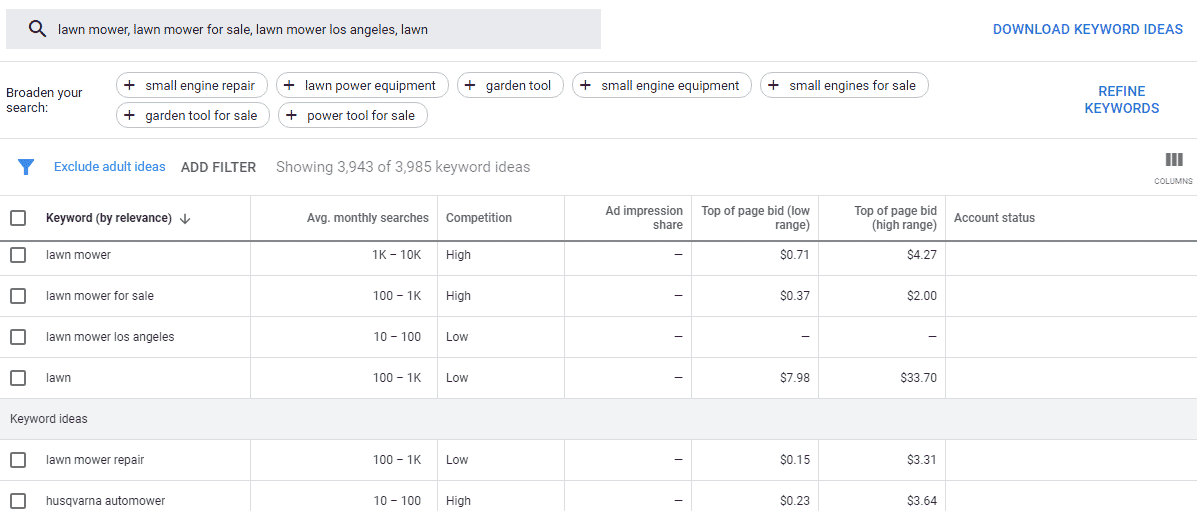
This is merely a sample to make you understand. You need a more in-depth list.
Actually, the beauty of keyword research is that you can target searchers in your locality. No one in LA would sit on his couch with his laptop and order a lawn mower in Japan if he can get the same product locally. Most probably, they will buy from close retailers.
So, if about 100 people are searching for ‘lawn mower Los Angeles’ and 10,000 search for ‘lawn mower’ in a month, the former are your ideal customers.
The keyword ‘lawn mower’ can be broad and cost you money since the intent can be different. Hence, it goes without saying that understanding the search intent of your customers.
Here is a blog that talks about this in detail.
There are three types of keywords:
Top of funnel keywords
These are basically keywords with less buying intent. They include words like ‘lawn mower,’ or ‘company X versus company Y.’ It shows that people are not interested in hiring your services, which mainly serve the people in LA.
Mid funnel keywords
These kinds of searchers are ready to buy but aren’t decided yet. They know that they need a lawn mower, but don’t know which company to approach. Hence, the search terms will have keywords such as ‘best’ ‘affordable’ or ‘review.’
Lower funnel keywords
These searchers are ready to buy. They have known and decided on a product or service to hire. They will input words such as ‘where to buy’ or ‘hire.’
Your campaigns, therefore, need to contain some middle funnel and lower funnel keywords to be effective. Top of funnel keywords might be broad and bring forth fewer conversions.
2. Creating ad groups
What are ad groups? They are a subdivision of your campaigns. They contain the different keywords you want to target in your campaigns.
You can have one campaign with several ad groups in it, targeting a specific segment of your customers.
Ensure your ad group matches the keywords you are targeting. Have a ‘Lawn mower LA’ ad group targeting people searching for that keyword.
You can even go the SKAG way. That means one ad group should only have one keyword.
The trick is to make the ad remain as relevant as it can to the target audience. Relevant ads will also increase the click-through rate and reduce the overall marketing cost.
A lower marketing cost increases your profit margin. Isn’t that what every marketer aims for; reduce marketing cost and increase revenue?
3. Set your campaign budget
How much is your Google ad campaign budget? $500? $5,000? Or $500,000?
Whichever the case, you need to earn a profit from your marketing campaigns.
Is there a need to launch ads when you are not getting a significant ROI?
No.
An important metric in marketing campaigns is conversion rates. How do you calculate it? It’s not rocket science.
If, for example, 100 people land on your site after searching for ‘lawn mower Los Angeles’ and one end up clicking the ‘order now’ button, the conversion rate will be 1%.
So, if a mower costs, let’s say $500, you will have already made $500 from the client. But how much will you need to have as your advertising budget to get that amount?
You see, Google charges a 30% commission on every conversion. So, out of the $500, you will still need to pay $150 to Google and remain with $350.
To get your maximum cost per click, multiply your conversion rates with your profit and Google’s commission, which is 30%.
In the above case, the maximum cost per click would be 1% * 0.3 * $500, which equals to $1.5 per click. That might appear high when you are starting out, but consider the ROI, not the cost. Keep optimizing, and the cost will reduce significantly
Let’s now see how much we need to set as our daily budget.
To get at least 10 clicks per day from the 100 people searching for a mower, you need to set $15 as your daily budget.
If only one person ends up purchasing, you will have $350 in profit after taking care of the Google commission. You will spend about $300 in 20 days and achieve $7,000 from your clients if only one person orders a lawn mower per day.
However, don’t think it’s merely a walk in the park. There are factors, which will determine this fate.
4. Write a compelling ad copy
Your ad copy matters a great deal in determining your click-through rate. No one would click a Google ad that doesn’t talk, walk, or sell.
Since Google allows limited texts in the heading and description, utilize your words carefully. Don’t use a word unless it’s poised towards making the person click on the display URL.
An excellent way to begin is to look at your competitor’s ads. Which words are they using? To understand this clearly, let’s analyze the Wayfair ad in this screenshot.

Keywords in the title: If you have noticed, they have included the keyword in the title. The title is vital because it’s the first thing the person will consider. Since the person is in LA, he will most likely not click on the second ad since it’s broad.
So, the first thing to consider is including your keywords in the title. Google allows up to three headlines, ensure you include the keywords in all of them.
Another interesting statistic shows that including a number in the description increases the CTR by 217%. Therefore, have something like ‘save up to $100 of your landscaping budget.’
A compelling service description: The second thing a person will look at is the description of your services. Reduce the risk level by offering freebies here.
Guess how the company has utilized that? It has offers free delivery for orders above $35, and a 70% off on all their products.
Google allows two ad descriptions.
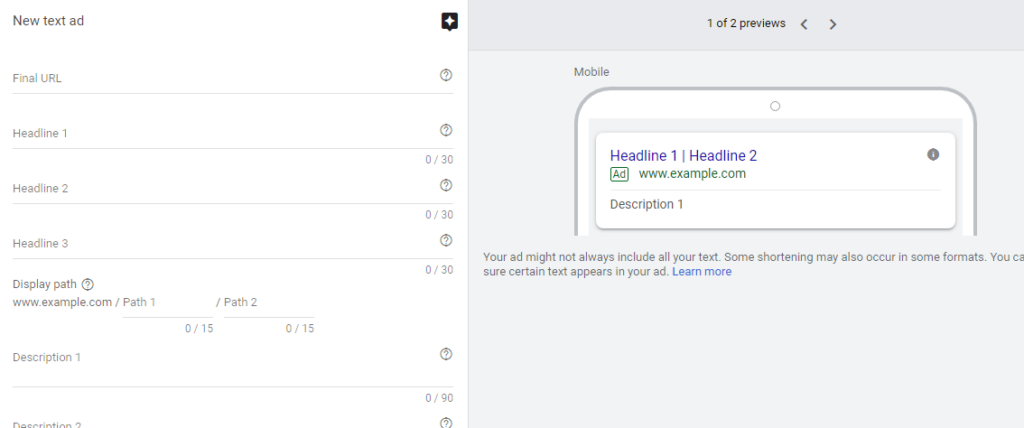
Utilize them effectively to talk to your customers.
The CTA button: The call to action should always imply a sense of urgency. Instead of merely ‘contact us,’ you can choose to include ‘contact us now.’ It has a huge difference. Instead of merely putting ‘get an estimate’ input ‘click to get a FREE estimate.’
Once you have studied your competitor’s ads, you can proceed to craft a more compelling ad and bid more for the same keywords. The higher CTR will make Google to reduce your marketing cost.
Is creating an ad feels like a nerve-wracking task for you? We have it all figured for you. You can use our FREE ad template [link to the template]. It’s a simple editable template specifically designed to create winning ads. You just need to edit the words based on your offer.
5. Tracking conversions
Your ads are up and running. How do you measure the success of your campaigns? You need to track conversions.
Google allows you to add a code snippet in your order completion page, such as your ‘thank you’ page. This shows that the person has successfully bought from you.
Once the person enters his billing information and clicks ‘submit,’ the next page is always a ‘thank you’ page. That’s where you need to place the code snippet.
To add the code, simply go to ‘tools and settings’ option like before and click the conversion option in the measurement category. Get the code and Google will track the conversions for you.
The video below will help you set up conversion tracking.
Would you want a simple and clear step-by-step video that shows you all these steps? Here’s another tutorial video will show you:
- How to create winning campaigns
- Adjusting settings to avoid wasting money
- Creating effective ad groups
Watch it below.
Besides, we also know you may not have the time to create, launch, and manage your campaigns, right?
You may also be getting your feet wet but want sales for your e-commerce products.
Whichever the case, we have your back when it comes to launching profitable Google Ads campaigns.
You see, when starting out, success in Google search advertising isn’t guaranteed. Even after following the experts, you can’t copy what someone is doing and expect to make the same results. You can learn from them and make fewer mistakes, however.
Avoid losing tons of your marketing resources by not applying the right Google Ads account setting. Sometimes, the wrong settings will make you target the wrong people.
We are explicitly targeting e-commerce brands. So, if you want to make profits fast and cut your marketing cost by almost half, contact us right away. We are your go-to company in Google Ads search campaigns.
What next after launching the campaigns?
After a few days of clicking the ‘submit’ button, Google will send you an email confirming that your ads are up and running.
Excited? Yes, you should be. Not all ads are approved that fast.
However, what should you do next? Sit and watch sales to trickle? It doesn’t work that way, buddy. You still need to be there, analyzing and checking the health of your campaigns.
This is what you need to do:
Identify new keywords: With the data from your campaigns, Google will help you to uncover new profitable keywords to bid on. Add the keywords in your campaigns and watch the conversions shot up.
Optimize your ads: Keep improving your less performing ads. Perhaps the copy needs a little alteration. Change that to a more compelling one.
Increase or reduce your bids: If you are ranking in position one, you may opt to reduce your bids and dominate at an affordable cost. But if your ads are appearing in third and fourth positions, consider increasing your bids to beat your competitors and get more clicks.
Create more ads: You can copy and paste an ad then modify it. Test out different versions of an ad to know the one that performs best. At the same time, you can pause less performing ads. Keep doing this until you are getting tons of leads from your campaigns.
The Verdict
Planning winning Google ads marketing strategy before hitting the ‘submit’ button is critical for the success of your campaigns.
You will need to apply the right setting to avoid targeting the wrong people, craft a winning ad copy, and set the right marketing budget that makes your ads get more clicks.
Keep checking how your campaigns are performing and optimize for better conversions. It’s by learning what’s not working that you can improve.
Otherwise, take action today and learn through experience.






